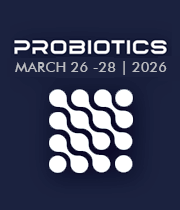Title : Carbon dots labeled probiotic as a fluorescent multifunctional biocarrier for trackable anticancer drug delivery
Abstract:
Probiotics are currently under active investigation in biotherapy owing to their recognized safety, multiple health benefits and physiological functions. Such characteristics led to the wide use of probiotics as bioactive agents in nutritional and pharmaceutical products as well as potential biological carriers for the administration and vaccines and more recently drugs. In comparison with biomaterial-based drug carriers, probiotics are characterized by sustainability, scalability, relatively low cost, inherent biotargeting ability with possible spacio-temporal control over drug release. Simple and economic bioimaging strategies would greatly enhance the capabilities of probiotics as drug carriers by allowing visualization of the movement of the probiotic/cargo combination in vivo and their potential interactions with target cells in vitro. The aim of the present study was to develop a trackable probiotic drug biocarrier using carbon dots (CDs) as emerging bioactive bioimaging agents and prodigiosin (PG), an anticancer secondary red bacterial metabolite, as model drug. Heat-inactivated Lactiplantibacillus plantarum (HILP) was labelled with glucose-derived carbon dots (CDs) to produce a fluorescent probiotic hybrid which was loaded with PG. CDs imparted green fluorescence to HILP cells and induced their aggregation as verified by transmission electron microscopy (TEM) and laser confocal scanning microscopy (LCSM), respectively. HILP effectively internalized CDs probably via glucose transporter proteins (GTPs) of the HILP cell membrane, forming a biostructure with retained fluorescence in PBS for a 3 month-study period at 4oC. Application of CDs/HILP as biocarrier for PG generated a stable green/red bicolor fluorescent combination permitting distinct tracking of both drug carrier and cargo. Cytotoxicity assay using Caco-2 and A549 cells revealed enhanced PG activity by CDs/HILP with synergy at different Fa levels and possible reduction of PG and CDs/HILP doses. LCSM imaging of PG-CDs/HILP-treated Caco-2 cells demonstrated improved cytoplasmic and nuclear distribution of PG as well as nuclear delivery of CDs. The CDs/HILP promoted PG-induced late apoptosis of Caco-2 cells and reduced their migratory ability as affirmed by flow cytometry and in vitro scratch assay, respectively. Prediction of PG molecular targets by molecular docking indicated PG interaction with mitogenic molecules involved in proliferation and growth regulation. Accordingly, CDs/HILP offers promise as multifunctional biocarrier having potential theranostic properties in addition to intracellular drug delivery and anticancer activity enhancing abilities. Findings represent an important contribution to the advancement of probiotics in the field of drug delivery and nanobiotechnology.
Audience Take Away
- Probiotics which have been always considered for encapsulation as biological agents can be used for the encapsulation of drugs and their efficiency as drug biocarriers can be enhanced by fluorescence labeling for identification and bioimaging in in vitro cell culture and in vivo studies.
- Carbon dots can be used for bioimaging or probiotics and enhancing their bioactivity using a simple and economic labeling technique.
- Audience will benefit by building on the study findings for the design of more efficient drug delivery probiotic-based biocarriers.
- Finally, the study provides a model for combing nanotechnology-biotechnology-pharmaceutical technology for advancing anticancer biotherapy.
- Others can use research for expanding their research and teaching.




